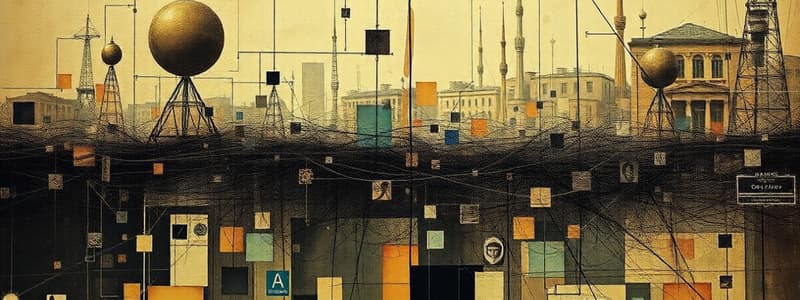Podcast
Questions and Answers
What transformation occurs when moving from the original network to the dual network?
What transformation occurs when moving from the original network to the dual network?
- Nodes become branches.
- Capacitances become resistances.
- Resistances remain resistances.
- Nodes become loops. (correct)
Which of the following would represent a fundamental loop in a network with nodes A, B, and C?
Which of the following would represent a fundamental loop in a network with nodes A, B, and C?
- B-C-A
- A-B-C
- A-B-C-A-B
- A-B-C-A (correct)
What does the Tie-Set Matrix allow you to apply in network analysis?
What does the Tie-Set Matrix allow you to apply in network analysis?
- Kirchhoff's Voltage Law (KVL). (correct)
- Current equations for branches.
- Ohm's Law for current.
- The Laplace Transform for time functions.
Which of the following describes the Cut-Set Matrix's function in circuit analysis?
Which of the following describes the Cut-Set Matrix's function in circuit analysis?
What occurs to capacitances during the transformation to the dual network?
What occurs to capacitances during the transformation to the dual network?
What is the primary advantage of transforming a circuit into the S-domain?
What is the primary advantage of transforming a circuit into the S-domain?
In the context of network analysis, what does a loop consist of?
In the context of network analysis, what does a loop consist of?
Which statement about the Tie-Set Matrix is true?
Which statement about the Tie-Set Matrix is true?
How are branches and nodes represented differently in dual network theory?
How are branches and nodes represented differently in dual network theory?
What is the relationship between inductances and capacitors in the dual network?
What is the relationship between inductances and capacitors in the dual network?
What does a network graph represent in electrical engineering?
What does a network graph represent in electrical engineering?
How many edges does a tree with $n$ nodes contain?
How many edges does a tree with $n$ nodes contain?
In a tie-set matrix, what does an entry of +1 indicate?
In a tie-set matrix, what does an entry of +1 indicate?
What distinguishes a loop from a tree in a network?
What distinguishes a loop from a tree in a network?
Which law states that the sum of currents at any node is zero?
Which law states that the sum of currents at any node is zero?
What is the purpose of a cut-set matrix?
What is the purpose of a cut-set matrix?
What does duality in network theory refer to?
What does duality in network theory refer to?
In a network graph, what do the nodes typically represent?
In a network graph, what do the nodes typically represent?
What is the fundamental property of a tree in graph theory?
What is the fundamental property of a tree in graph theory?
What can a cut-set do in a network analysis?
What can a cut-set do in a network analysis?
What is true about the edges in a tree with n nodes?
What is true about the edges in a tree with n nodes?
Which of the following correctly characterizes a loop in a network?
Which of the following correctly characterizes a loop in a network?
What do entries in the Tie-Set Matrix indicate?
What do entries in the Tie-Set Matrix indicate?
Which law describes the sum of voltages around any closed loop in a network?
Which law describes the sum of voltages around any closed loop in a network?
In a Cut-Set Matrix, what does an entry of -1 indicate?
In a Cut-Set Matrix, what does an entry of -1 indicate?
What is primarily represented by the nodes in a network graph?
What is primarily represented by the nodes in a network graph?
What does the term 'duality' in network theory imply?
What does the term 'duality' in network theory imply?
What aspect differentiates a tree from a loop in graph theory?
What aspect differentiates a tree from a loop in graph theory?
How is the Cut-Set Matrix structured?
How is the Cut-Set Matrix structured?
What does Kirchhoff's Current Law state?
What does Kirchhoff's Current Law state?
What transformation occurs to resistances when moving to the dual network?
What transformation occurs to resistances when moving to the dual network?
Which of the following sequences depicts a fundamental loop and corresponding branches?
Which of the following sequences depicts a fundamental loop and corresponding branches?
What does the Tie-Set Matrix allow for in network analysis?
What does the Tie-Set Matrix allow for in network analysis?
In the context of dual networks, how do capacitances behave?
In the context of dual networks, how do capacitances behave?
Which statement best describes the application of the Cut-Set Matrix?
Which statement best describes the application of the Cut-Set Matrix?
How does the Laplace Transform aid in circuit analysis?
How does the Laplace Transform aid in circuit analysis?
What is the primary purpose of transforming a circuit into the S-domain?
What is the primary purpose of transforming a circuit into the S-domain?
In a Tie-Set Matrix, what does an entry of +1 typically indicate?
In a Tie-Set Matrix, what does an entry of +1 typically indicate?
Which of the following best describes a tree in network theory?
Which of the following best describes a tree in network theory?
What occurs to nodes in the dual network compared to the original network?
What occurs to nodes in the dual network compared to the original network?
Flashcards
Network Graph
Network Graph
A visual representation showing connections between network points (nodes) and elements (edges).
Tree (Graph Theory)
Tree (Graph Theory)
A connected graph without any loops, containing all the nodes.
Loop (Graph Theory)
Loop (Graph Theory)
A closed path in a network starting and ending at the same node, no node visited twice except for start/end.
Tie-Set Matrix
Tie-Set Matrix
Signup and view all the flashcards
Cut-Set Matrix
Cut-Set Matrix
Signup and view all the flashcards
Kirchhoff's Current Law (KCL)
Kirchhoff's Current Law (KCL)
Signup and view all the flashcards
Kirchhoff's Voltage Law (KVL)
Kirchhoff's Voltage Law (KVL)
Signup and view all the flashcards
Network Equilibrium Equations
Network Equilibrium Equations
Signup and view all the flashcards
Duality-Network Transformation
Duality-Network Transformation
Signup and view all the flashcards
Fundamental Loops
Fundamental Loops
Signup and view all the flashcards
Tie-Set Matrix
Tie-Set Matrix
Signup and view all the flashcards
Cut-Set Matrix
Cut-Set Matrix
Signup and view all the flashcards
Dual Network (analysis)
Dual Network (analysis)
Signup and view all the flashcards
Fundamental Loops
Fundamental Loops
Signup and view all the flashcards
KVL
KVL
Signup and view all the flashcards
KCL
KCL
Signup and view all the flashcards
S-domain
S-domain
Signup and view all the flashcards
Laplace Transform
Laplace Transform
Signup and view all the flashcards
Circuit Element Transformation (s-domain)
Circuit Element Transformation (s-domain)
Signup and view all the flashcards
Network Analysis
Network Analysis
Signup and view all the flashcards
Network Graph
Network Graph
Signup and view all the flashcards
Tree (Graph Theory)
Tree (Graph Theory)
Signup and view all the flashcards
Loop (Graph Theory)
Loop (Graph Theory)
Signup and view all the flashcards
Tie-Set Matrix
Tie-Set Matrix
Signup and view all the flashcards
Cut-Set Matrix
Cut-Set Matrix
Signup and view all the flashcards
KCL
KCL
Signup and view all the flashcards
KVL
KVL
Signup and view all the flashcards
Network Equilibrium
Network Equilibrium
Signup and view all the flashcards
Duality (Networks)
Duality (Networks)
Signup and view all the flashcards
Fundamental Loops
Fundamental Loops
Signup and view all the flashcards
Tie-Set Matrix
Tie-Set Matrix
Signup and view all the flashcards
Cut-Set Matrix
Cut-Set Matrix
Signup and view all the flashcards
Dual Network
Dual Network
Signup and view all the flashcards
Fundamental Loops
Fundamental Loops
Signup and view all the flashcards
KVL
KVL
Signup and view all the flashcards
KCL
KCL
Signup and view all the flashcards
S-domain
S-domain
Signup and view all the flashcards
Laplace Transform
Laplace Transform
Signup and view all the flashcards
Circuit Element Transformation (s-domain)
Circuit Element Transformation (s-domain)
Signup and view all the flashcards
Network Analysis
Network Analysis
Signup and view all the flashcards





